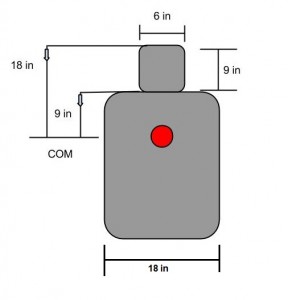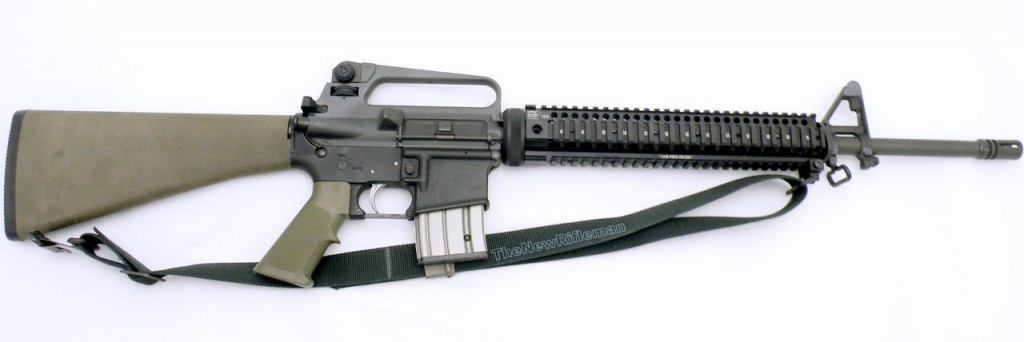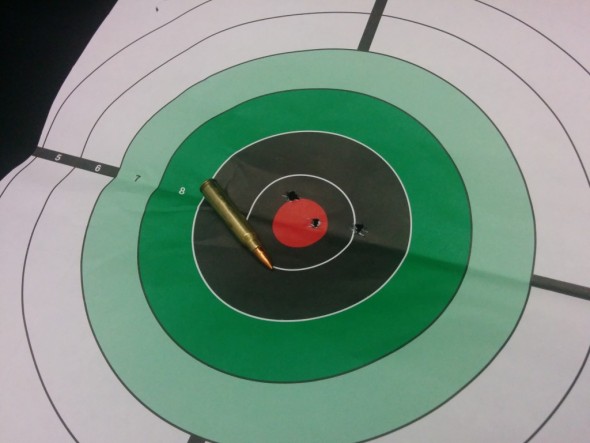A few years ago, I decided I wanted to become a rifleman. A practical rifleman. Through disciplined self practice, and help from the online community, I have been able to ever expand my skills from a 100 yard skill-set to a 600 yard comfort zone. If I can do it, anyone can, but people believe they can’t. I have run into many AR owners who think that if they can’t shoot 1-2 inch groups like they see online, that they are not shooting well. They perceive their rifle equipped with a red dot as being too imprecise to carry them past close range. They doubt their skills, but they have not practiced them. They think they can’t, therefore they don’t shoot at longer ranges.
Let’s knock that mental wall down, and develop a simple shooting program for all the new AR shooters out there. Let’s identify an easy to master system that can carry their rifle out to distances they once dismissed. Today we are going to create a basic program to get you (or those who need this) a tool-set to drop rounds on a target to 400 yards. Let’s get started:
AR15s Everywhere, No Two Alike:
Due to the variety of weapons we are dealing with, it is important to define what we are working with. Our average new AR15 shooter is likely running his or her gun as a carbine in a 16 inch format topped off with a back up iron sight, a red dot sight, or a variable scope. There is likely to be a tactical sling, but may be a model that is not capable of being used to steady the shot. The new shooter may be shooting anything from 50 grain varmint rounds to 55, 62, or 69 grain SMK. If we are lucky, the gun is zeroed at 50/200 or 100 yards.
We have wiggle room in the rifle setups. Different zero’s, different ammo choices, and different sighting systems will be present among any number of shooters heading to the range this weekend… While each individual setup is unique… are they unique enough to make us miss a man-sized target out to say, 400 yards? Let’s look at the data:
Velocities tailored to a 16 inch barrel, 1000ft elevation, 59 degrees Fahrenheit, 200 yard zero, (G1)
| Yards | 50gr V-Max | 55gr xm193 | 62gr XM855 | 69gr SMK |
| 200 | 0 | 0 | 0 | 0 |
| 300 | -7.3 | -7.1 | -7.7 | -8.86 |
| 400 | -23.7 | -22.7 | -23.5 | -26.9 |
Those are very different loadings, but you see with a 200 yard zero the drops are all within 4 inches of each other. At 400 yards and under, your drops won’t be different enough to matter with whatever bullet you choose!
Three Simple Holds:
Ballistically, many of the popular loadings are within a few inches of each other regarding bullet drop. Out to 400 yards with a 50/200 yard zero, we have strike points that stay well within a minute of each other. The first step in stretching a rifles legs is to understand the path the bullet takes once it exits the muzzle. While shooters may not memorize the above table, they will use it to understand our next point: those drops correspond well with repeatable reference points on a human silhouette.
 Above is BDC man. I made him based on average human head width, height, shoulder width, ect. He is a great display for discussing “the chest, the head, the hat.”
Above is BDC man. I made him based on average human head width, height, shoulder width, ect. He is a great display for discussing “the chest, the head, the hat.”
The chest is your 0-200 yard point of aim for any of the discussed loadings. The 50/200 yard zero is flat shooting enough that we don’t need to change holds inside of 200. The head is your 300 yard hold and will drop rounds slightly above center of mass for any of the discussed loadings. The hat is your 400 yard hold; visualize a hat and shoot it off the head; you will easily drop rounds into the mid to low torso of your target at 400 yards with any of the discussed loadings.
Using those three references, we can see all our common loadings above easily drop right into the target. For example, shooting with 50 grain V-Max at 400 yards, the shooter should visualize a hat on the targets head, and put dot on the hat to shoot it off. Bam, you just compensated for 23.7 inches of drop without the need for a fancy BDC reticule.
So We Don’t Need A Scope with BDC?
No, not at all. Not at these distances. Magnification helps acquire the target and will no doubt help you in firing upon targets at these ranges, but a BDC reticle is not necessary for this basic skill. A scope with cross hairs will suffice, or even a red dot sight with a 4 MOA dot. In fact, I prefer a red dot for this exercise over irons since it doesn’t obscure the target. Irons (as in a shooter with a single plane BUIS) will have the most difficulty as 1) they obscure the target as we compensate for drop, and 2) the irons require focusing on the front sight instead of the target.
If your using irons, best practice will be to either use the adjustable drum, or zero your non-adjustable flip ups with a 25-300 battle zero which will enable you to aim your irons center of mass out to 300 yards without worrying about drop. If you are using a red dot or a simple optic, then you will have it much easier. A 2 MOA or 4 MOA red dot obscures less of your target than the irons and is a finer aiming reference than the wide A2 front sight for practical shooting. I still practice with irons, but I do not hesitate to recommend a red dot sight or a magnified optic.
Practical Ranging:
So the three holds are easy, but we need to learn a quick way to estimate distance. This is a skill that needs to be developed on your own and for your individual sighting system… but here is a handy chart if you have a red dot and need it done the easy way: The top row represents dot size and the red is where the dot should begin to obscure the targets head, and the blue is where is should begin to obscure or match the width of the shoulders. 4 MOA red dots seem to have the most utility for ranging a target.
| Yards | 2 MOA | 3.5 MOA | 4 MOA | 7 MOA | 12.9 MOA |
| 100 | 2 | 3.5 | 4 | 7 | 12.9 |
| 150 | 3 | 5.25 | 6 | 10.5 | 19.35 |
| 200 | 4 | 7 | 8 | 14 | 25.8 |
| 250 | 5 | 8.75 | 10 | 17.5 | 32.25 |
| 300 | 6 | 10.5 | 12 | 21 | 38.7 |
| 350 | 7 | 12.25 | 14 | 24.5 | 45.15 |
| 400 | 8 | 14 | 16 | 28 | 51.6 |
| 450 | 9 | 15.75 | 18 | 31.5 | 58.05 |
| 500 | 10 | 17.5 | 20 | 35 | 64.5 |
As you see, its not weapon capability shooters lack, simply knowledge. Developing your own charts, evaluating your own data, can help you develop an easily applied approach to practical shooting. With all the BDC calculators available for your phone, all the shooting information and skills available at your fingertips, there has never been a more easy time to self learn marksmanship.
I have been teaching myself to shoot for a few years now. My time spent online and at the range soaking up knowledge has permitted me to achieve a dream of mine… to develop my skills as a Rifleman. With only advice from fellow bloggers and forums, I was able to develop my skill-set to shoot in my first NRA High Power match with a pot-luck A2 rifle and score 688-4x. While this may be small beans to some, it was important to me; it showed me that I could develop my skills without formal instruction and that if I can do it, anyone can.










Sucks for me since I run an Eotech with a 1 MOA for in the center haha! Great info about ranging and holds. I’m surprised more people aren’t talking about this.